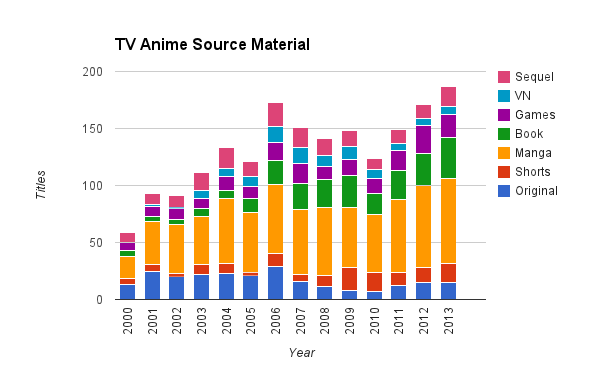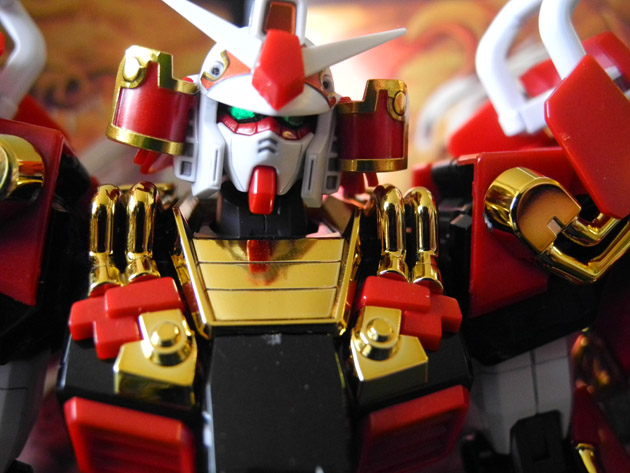You might remember my friend Grant from On watching Free! with straight men. While I’m finishing up the final revisions to my book, I’ve asked Grant to wax philosophical on his favorite anime of the moment, Kill La Kill.
Grant is a lot more interested in academia than I am, and this post is both longer and more analytical than my average anime review. I’m excited to see what you guys think.
Warning, there are a ton of spoilers here, both for Kill La Kill and for Gurren Lagann.
Tengen Toppa Gurren Lagann is probably my second favorite anime ever, and certainly my favorite anime to talk about. Many reviewers—even those that like the show—see it as mostly random fun. As happy as I am that other people like it for any reason, I’m always a bit disappointed in that evaluation. To me, Gurren Lagann is more philosophically “deep” than many shows traditionally considered such.
Just because you don’t have characters engaging in extended discussions or monologues with lots of philosophical and psychological jargon doesn’t mean a show isn’t saying some very deep things. It just might be saying them visually, symbolically, even allegorically. Gurren Lagann’s text is incredibly dense and incredibly semantically rich, and it’s a shame not to see more in it than the hotblooded yelling, “randomness,” and technicolor explosions.
I say all this so that you’ll understand that my expectations for Kill la Kill, produced by the same writer/director team as Gurren Lagann, were incredibly high. I binge-watched the first 16 episodes over a couple days, but it was only with the release of episode 17, “Tell Me Why,” that I think I developed a fairly solid handle on what is going on in the show thematically.
Gurren Lagann pitted human flourishing and anarchy against Malthusian doomsaying and tyranny, but a major sub-theme was how people are shaped by their parents and how they react to their parents’ legacy.
Gurren Lagann’s Rossiu Adai was the bastard son of the elder of Adai village. The elder ruled Adai village as a theocracy, using religion to veil the way he carefully managed the subterranean town’s population by forcible exile to the inhospitable surface. Faced with a similar population management problem as an adult, Rossiu combined a cold, calculating, managerial approach with strongarm tactics, both traits he learned from his father.
Kamina is driven to follow after his father when he escapes Jiha village. Kamina sees making it to the surface as a hurdle his father had set for him to clear before he could join him, physically and in manhood. Kamina also acts as a foster parent for Simon, and much of Simon’s character growth comes in reaction to his belief that he can never live up to Kamina’s example. His attempts to replace the void in the group left by Kamina’s death by emulating Kamina fail. He can only step into a leadership role after accepting that it’s okay for him to do it his own way.
I originally thought that Kill la Kill was going to be primarily about fascism. The first words we hear in the series are about the Nazi party’s rise to power, and indeed the entire school is run fascistically. Satsuki Kiryuin rules the school as her personal fiefdom, while arguing, farcically, that the system she’s built is a “meritocracy.”

I half expected Satsuki to add “We’ve always been at war with Eastasia” to the end of the monologue screenshotted above. We even get a none-too-subtle reference to eugenics in the form of the school’s “Naturals Election.”
But episode 17 upends things quite a bit. Satsuki betrays her mother Ragyo with a literal stab in the back, and tells us emphatically that she acts not to usurp her mother’s position but to depose her and fight against her cause—this coming in the very same episode that our heroine Ryoko decides to embrace her own father’s struggle against the invading Life Fibers.
Director Hiroyuki Imaishi and writer Kazuki Nakashima are revisiting the Gurren Lagann‘s theme of family influence in Kill la Kill, this time bringing it to the center of the story.
Ryuko and Satsuki are set up early as a diametric pair, and it’s worth exploring the depths of this inverted parallel. Each has a missing parent—Ryuko’s mother died, and Satsuki’s father has been absent except in flashbacks. But while Ryuko and her father Isshin were distant, Satsuki and her mother Ragyo are uncomfortably intimate. Each girl’s other parent was or is the head of one of two opposed organizations–Nudist Beach and Revocs (styled “REVOCS”). Each girl received a kamui, but each gift carried a different set of expectations.
First let’s consider Ryuko, Isshin, and Senketsu. Mikisugi tells us—and we have as yet no reason to doubt him—that Isshin created Senketsu to protect Ryuko, presumably from those who would do her harm because of her heritage. Ryuko names Senketsu herself. We’re told that the name means “first blood,” and Ryuko chooses the name because it was the initial contact with her blood that awakened Senketsu. I certainly wouldn’t be the first commentator to point out the the name also signifies a first menstrual cycle—a rite of passage into womanhood indicating the start of sexual maturity. Further than that, though, we can see meaning in the fact that Ryuko is literally tied by blood to Senketsu, who was made by her father, and blood relative, Isshin, and who shares Isshin’s eye-patched visage.
The primary problem-solving tool that Isshin bequeaths to Ryuko is self-reliance. She uses that inheritance in her quest to learn more about her father’s motives and beliefs and to discover the reasons for his murder. Ryuko constantly tries to avoid dragging others into her personal battles, only grudgingly bringing along members of her surrogate family, the Mankanshokus.
The closest analogue Ryuko has in the cast of Gurren Lagann is Simon. As Simon steps out of his deceased foster parent, Kamina’s, shadow to lead the organization Kamina built, so Ryuko chooses to follow her deceased father’s footsteps and fight alongside the organization he built. Before they can assume additional responsibility, both Simon and Ryuko go through a period of withdrawal as they overcome personal misgivings about their own abilities. Simon has trouble accepting Kamina’s death and has apprehensions about being able to “replace” him as he feels the others expect, and Ryuko doubts her ability to maintain control while wearing Senketsu. Like Simon, Ryuko is willing to fight alone, but appreciates allies that stand with her of their own volition.

Now let’s look at Satsuki, Ragyo, and Junketsu. Satsuki is given her white kamui, Junketsu, by her father as a “wedding dress,” thereby tying Junketsu to a very different rite of passage than the one to which Ryuko’s Senketsu is tied. Compared to menstruation, marriage carries very different cultural baggage. The white of a wedding dress is symbolic of virginal purity, and indeed “Junketsu” means “purity.” Satsuki is being groomed as her mother’s successor as head of the Revocs Corporation and as instrument of the Life Fibers.
Junketsu is meant as a tool for Satsuki to use as she grows into the role she is expected to fill–both as a woman and as her mother’s successor. There are a million strings attached. Satsuki is also tied by blood to her kamui, but while Ryoku and Senketsu have a symbiotic relationship, Junketsu is a burden for Satsuki to wear. Even though it enhances her abilities, it’s primarily a parasite. Likewise, while Ryoku feels liberated by her burgeoning connection to her father, Satsuki is stifled by her connection with her mother.
The primary problem-solving tool in which Ragyo trains Satsuki is the domination of others. Satsuki uses that skill in her attempt to get out from under her mother’s thumb and quash her mother’s ambitions. Satsuki is obsessed with building an ever-stronger army of subordinates, picking her top officers as much for their loyalty as their strength. She punishes disobedience with death and rewards success in carrying out her will with more powerful weapons and positions of honor and authority.
Satsuki’s nearest counterpart in Gurren Lagann is Rossiu. In the conversation that sparked this article, Lauren herself pointed out to me that the two even look similar. Like Rossiu, Satsuki is faced with an impending disaster of apocalyptic proportions, and like Rossiu, she responds to that threat in the only way she knows how: by treating people like chessmen, with no consideration for their autonomy and a disregard for their rights to keep their lives. Both Rossiu and Satsuki learned to approach problems this way from watching their parents’ respective examples as children. Both Rossiu and Satsuki commit great crimes in their efforts to save humanity, but the audience understands why they might act this way and sympathizes even if they don’t approve.
The story of Kill la Kill thus far has been the story of two girls exploring what their family ties mean to them and how they react to developing a fuller understanding of their relationship with their parents and their parents’ legacies. What I’m most interested in finding out in the remaining episodes is what the fallout from Satsuki’s staggering hypocrisy will be, and whether she’s redeemable. Coming out of Satsuki’s mouth, words like “purity” and “meritocracy” drip with irony, and she is using totalitarian methods to fight a tyrant. Will she get some kind of comeuppance? And will she emerge from her journey broken or healed?
In Gurren Lagann, Simon absolves Rossiu of his misdeeds while demonstrating through his actions that there is an alternative way to approach things, a way that is collaborative and voluntary as opposed to dictatorial and coercive. Since Kill la Kill is about family, I wonder if Satsuki will learn that she should have relied more on the family that she has built for herself, the Elite Four, and abandoned the notion of rule by terror.
Can tyranny destroy tyranny? Can you beat the system by playing by the system’s rules? Gurren Lagann’s answer was an emphatic “no,” and Kill la Kill has already played with this question in microcosm in episode 7, “A Loser I Can’t Hate,” wherein Mako and Ryuko’s “Fight Club” threatens to tear the Mankanshoku family apart.
That said, where we go from here is anybody’s guess. Gurren Lagann became well-known for its ability to repeatedly outdo itself in shocking its audience, despite that audience’s perpetual certainty that this time it had seen everything. In light of that, I wouldn’t be surprised if Kill la Kill has a few aces left up it’s sleeve. As things stand it is already a worthy successor to Gurren Lagann and an impressive first show from Trigger. Will Kill la Kill embrace the path of it’s older sibling, or forge one anew?












